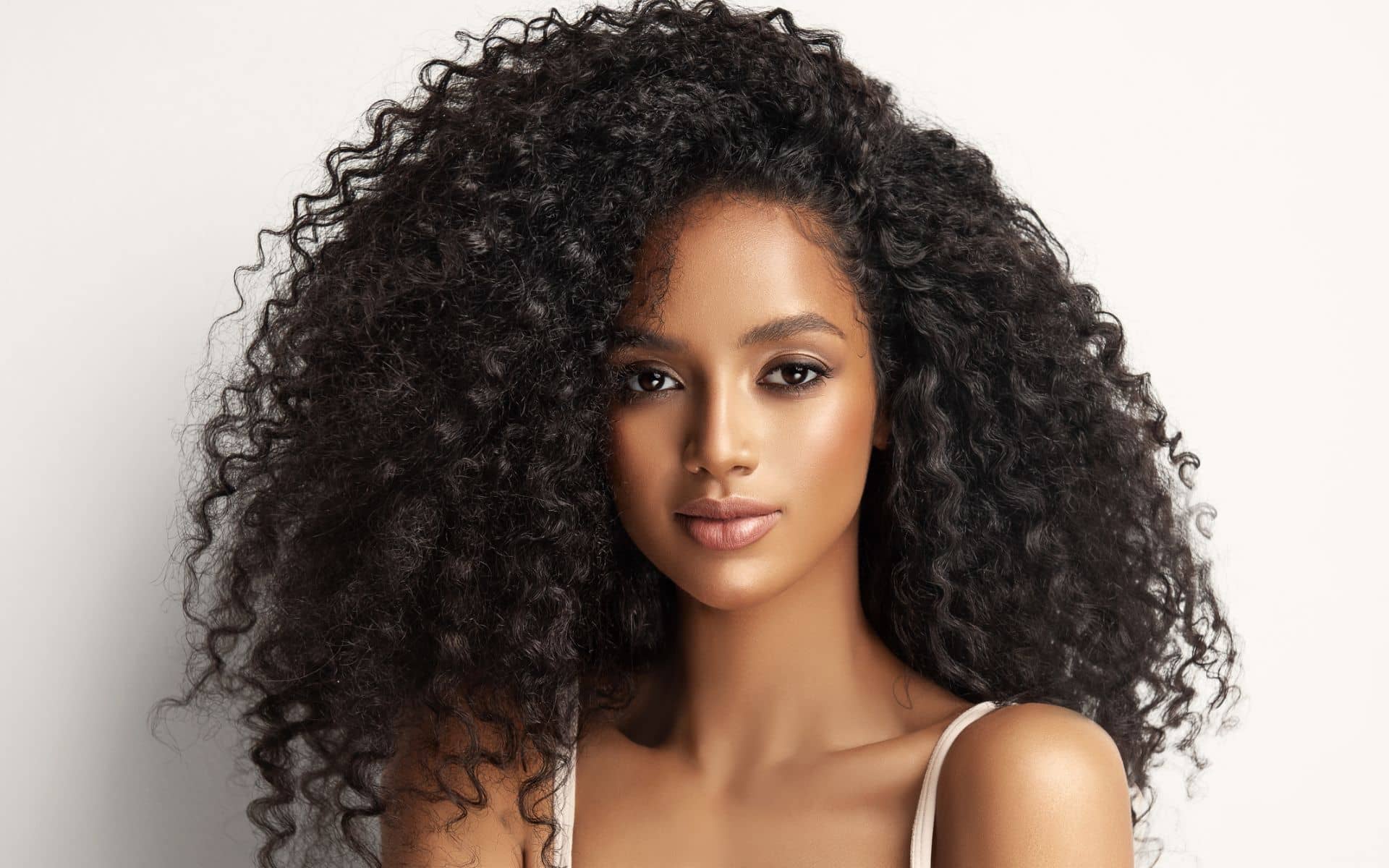Split ends are those pesky little buggers that can seriously sabotage your length retention goals. Unfortunately, on afro hair, split ends are harder to spot due to the natural coiling of our hair strands. Unless you frequently blow out your hair, you might not even notice them and mistakenly think your hair is healthy. But beneath those beautiful curls and coils,, you could have damaged, thinning ends!
In this comprehensive guide, we’ll walk you through everything you need to know about split ends on afro hair—how to spot them, treat them, and prevent them. Say goodbye to split ends and hello to healthy, vibrant hair. Let’s dive in and discover the secrets to maintaining radiant, split-end-free afro hair!
What are split ends?
If you’re experiencing split ends, you’re not alone! They’re caused from a variety of factors such styling, excessive use of heat, colour treatment and lack of moisture. Split ends are created from fibres breaking or splitting as a result of damage. They typically occur on the ends of your hair which is the weakest and most fragile because it’s the oldest part of your hair strands.
Afro hair is naturally fragile and split ends are a sign the outer layer of your hair strands are damaged. Although, typically occur on your ends – they can easily appear on other sections of your hair and can travel upwards to to the rest of your hair shaft leading to breakage.
It has a detrimental impact on your hair strands if not treated quickly. Leaving your hair brittle, dry and frizzy. As afro hair shrinks and coils around each other easily – it makes it harder for you to spot the splits. In the moment, you might feel your hair isn’t growing but you’re likely to be losing more length then retaining it because your ends are splitting at a faster rate due to the damaged cuticles.
Split End Types

How to identify if your afro hair has split ends?
Spotting split ends on natural hair can be quite tough bearing in mind your hair strands shrink up to 70% of its length. If you’re a natural who doesn’t blow out or straighten their hair regularly, it’ll make it even harder for you to spot. Here are 5 signs to help you identify if your afro hair has split ends.
- Your ends feel and appear thin
- Your ends are excessively dry and feel brittle
- Hair snags and knots easily
- Detangling isn’t as smooth as it is normally and you find your hair is tangling easily
- Your ends are uneven
How do I get rid of split ends in afro hair?
Now you know how to identify split ends.You might be wondering, how do i get rid of split ends on my natural hair. The simplest answer is to get them trimmed and if your split ends have travelled quite far up the hair shaft then get a cut for a fresh start. If you’re not a fan of getting rid of your split ends in one go – you can gradually trim them over a 3 to 6 month period. Just remember, your hair health is more important than length so the sooner you snip them the better it is for your hair.
It’s best to go to a professional instead of trimming your own hair but just be careful not to go to a scissor-happy stylist who may cut off more than is required. Do your research, watch instagram or tik tok videos to see if the stylist meets your expectations and go from there.
If you prefer to get rid of your own split ends. Watch this step by step tutorial by Healthy Afro Hair.
TIP : Purchase scissors specifically for hair so you don’t create any further damage.
How to prevent split ends?
Unfortunately split ends are inevitable and are likely pop up on your hair strands every couple of months. Here are 6 top ways to stay on top of them and prevent them from appearing on your afro hair.
1. Stay on top of your trims :
Aim to trim your hair every 3 months. You can stretch to 4 months if you prefer but just don’t go past that mark. Read our article on the benefits of trimming your natural hair for more insight.
2. Moisture Moisture Moisture :
We can’t stress enough how important moisture is to keep your hair afro hair hydrated to minimise breakage or split ends. You can utilise moisture in a variety of ways from using hair masks, deep conditioning treatments and moisture intense leave in-conditioners.
Read our post on Best Deep conditioners for Type 4 Hair and Easy Homemade Deep Conditioner recipes if you need some inspiration on what products to try!
3. Protect Ends at Night :
Sleep with a satin or silk scarf to prevent friction on your ends. For that added protection – get a silk pillowcase especially if your bonnet falls off at night.
4. Protect your hair whilst using heat :
Always use a heat protectant when styling with heat and minimise how often you use it. For instance, you don’t want to straighten your hair every day. If you’re rocking a straight silk press, wrap your hair at night and avoid re-pressing your hair. Read our article on Silk Press Tips to help you maintain your straightened hair.
5. Utilise protein treatments :
These treatments strengthen your hair shaft and prevent splits. Be careful not to overload your hair with protein as it can make your hair brittle. If you’re a high porosity natural you can use it every 1 to 2 months AND low porosity naturals every 2 to 3 months.
6. Be careful when dyeing or colouring your hair :
Unfortunately Hair dye contains chemicals that can weaken and damage the hair shaft, leading to splits. Getting your hair dyed by a professional can ensure proper application and minimise damage. Use deep conditioning treatments and leave-in conditioners to keep hair hydrated.
Best split end treatment for black hair
There are a variety of treatments on the market that help keep split ends at bay. These are temporary fixes and should not be used as a replacement to trimming your ends. However, they can be used as an aid to help prevent split ends whilst acting as an extra layer to seal your ends so they don’t fray easily.
Here are 4 split end treatments that work well on afro textured hair.

The treatment is designed to treat and prevent splits by strengthening the hair fibres and sealing the ends. It contains plant based proteins, niacinamide and glycerin. Great for women who have curly, coily or damaged hair.

A lightweights 2 in 1 cream which treats split ends and repairs damaged hair. The product claims to seal 96% of split ends due to its bond curing technology. It’s a versatile product which can be used as a styling cream or a leave in treatment

This treatment is great for anyone looking to repair, prevent and strengthen their split ends. It’s infused with argan oil and enriched with a blend of vitamins and quinoa proteins making it a natural alternative.

Designed specifically for curly hair – this product repairs split ends. It uses an advanced technology to repair existing damage and prevent future damage by re-linking the broken bonds. It’s silicone and paraben free, created with the support of dermatologists.
FAQ’s re; Split Ends
1: Why does my afro hair keep breaking and How to stop afro hair from breaking?
Your afro hair is breaking due to something in your hair routine. There are many factors that contribute to breakage such as lack of moisture, detangling on dry hair, not using the right products, tight hairstyles, diet and not using the right styling tools. As 4A, 4B and 4C hair strands are quite fine in nature. There are various elements you’ll need to incorporate into your natural hair routine to keep your hair healthy and eliminate breakage. Aside from staying on top of your trims and keeping split ends at bay. Here are 6 key TIPs you can incorporate into your hair regimen:
- Incorporate moisture retention techniques such as the LOC or LCO method.
- Don’t use products with harsh ingredients – opt for silicone and sulphate free products.
- Incorporate treatments such as deep conditioning and hair masks
- Utilise steam to open your hair cuticles and ensure moisture penetrates through the hair shaft
- Detangle on damp hair and use a product with a great slip
- Be careful with protective styling : Make sure your hair isn’t too tight and create a haircare routine whilst wearing these styles. This should include cleansing your scalp and getting the adequate amount of moisture into the hair strands
Here are some post you might find helpful for protective styling 👍
The truth about braids for hair growth and length retention
Mini Twists : The Ultimate style for retention and hair growth
Can sew-ins contribute to natural hair growth?
How to rock clip in extensions on Type 4 hair?
2: Why does black hair break so easily?
Unfortunately due to the nature of our coil and curl structure, afro type 4 hair has the tendency to break easily. However, bearing that in mind – the main culprit for breakage is dryness, lack of moisture and manipulation from daily styling which is why it’s important to treat your hair with TLC.
If you’re experiencing excessive breakage, a quick fix is to incorporate moisture retention techniques such as the LOC or LCO to increase hydration into your hair strands to help with elasticity whilst strengthening your hair strands.
If your breakage is due to a change in your hair routine i.e. a chemical treatment, excessive heat or bleaching. Then STOP now, the best way to eliminate breakage is to identify the route cause and tackle it straight away.
3: How to tell if afro hair is damaged?
A quick tell-tell sign of damaged afro hair is the change in texture. If your hair feels extremely dry and brittle then it’s an early warning sign your hair is damaged. If not careful, this could lead to breakage – you may need to review the products you’re using to ensure they have moisturising properties such as film-forming humectants to ensure your hair cuticles are actually being nourished.
Another sign of damage is if your curl or coil pattern is straight and doesn’t revert back. Let’s say you had a silk press or recently bleached your hair. Your coil pattern should return back to normal. If it remains straight then you’ve experienced some form of damage within the hair cuticle itself and the only way to get rid of it is by cutting the dead hair.
If you’re experiencing excessive frizz in comparison to normal. Then you probably have some form of damage – afro hair is naturally frizzy but if your frizz is out of control then this is a sign your cuticles are raised and having difficulty retaining moisture.
4: Can damaged afro hair be repaired?
With the right level of TLC, you can nurse your damaged afro back to health. You’ll need to utilise treatments such as moisture rich deep conditioning masks and/or protein treatments depending on the level of damage. If your ends are completely damaged – you’ll need to start with a fresh cut to give you the best possible chance of reviving your hair health.
You’ll need to cut back on the things that led to the damage in the first place such as using excessive heat, bleaching hair, tight hairstyles etc.
If you’re on the hunt for what treatments to use, read the following articles:
8 Deep Conditioning Treatments for 4A, 4B & 4C Hair
Easy Homemade Deep Conditioners To Try for Natural Hair
5: Does split ends stop hair growth?
Split ends does not stop the rate of growth from your scalp but can hinder your length retention goals. Depending on how high the split ends have travelled up the hair shaft – your hair will start breaking. Making it appear like your hair is not growing. But instead it’s breaking off at a faster rate than it’s actually growing.
FINAL THOUGHTS
Dealing with split ends on afro hair can be challenging, but with the right knowledge and care, you can maintain healthy, vibrant hair. This guide has covered how to identify split ends, methods to treat them, and preventive measures to keep your hair in top condition. Remember:
- Identify Split Ends: Look for signs like thin, dry, brittle ends and increased tangling.
- Treat Split Ends: Trim them regularly, preferably with the help of a professional, and consider using targeted split end treatments.
- Prevent Split Ends: Keep your hair moisturised, protect it from heat and friction, and handle it gently.
Split ends are a natural part of hair wear and tear, but with these tips, you can minimise their impact and keep your afro hair healthy and strong. If you notice an increase in split ends and breakage after changing your hair care routine, stop using the new product or method immediately and switch to one that supports your hair’s health.
We hope you found this guide helpful and informative. For more tips and product recommendations, check out our related articles on deep conditioning treatments, protective styling, and more.








































